
These definitions and illustrations are from the MiBAC Music Theory Page - Music Software - http://www.mibac.com/Pages/Theory/Main_Theory.htm.
Terms and Concepts
Beat - The underlying, evenly spaced pulse providing a framework for rhythm.
Meter - The pattern in which a steady succession of rhythmic pulses is organized.
Create a steady beat by tapping your foot or clapping your hands. A metronome is a visual and auditory way to discuss the steady beat. The higher the number you set on a metronome, the more beats per minute and the faster the arm moves. I often march to a regular beat, then start to slow, speed up, slow again to demonstrate irregular beat. Use words and phrases as examples. For example - murmur has two equal syllables, but kachoo is irregular because of the accent on the second syllable. The rhythm of word syllables and accents can help students hear rhythm patterns.
Time
signatures are used to indicate how the musical rhythm and meter is organized.
The rhythm and meter of a piece of music are independent of the tempo. Whether
the piece is played fast or slow, the rhythm and meter stay the same. The upper
number in the time signature indicates the number of beats in a measure. The
lower number indicates which note value receives one beat.

This
table shows the music symbols and names of the most commonly used notes.
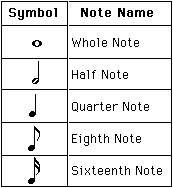
Each of these
notes is half as long as the note above it.

A dot
following a note or rest increases its duration by half the original value.

This table
shows the music symbols and names of the most commonly used rests. Rests are
used to indicate silence.


Taken from http://www.mibac.com/Pages/Theory/Main_Theory.htm
Pitch is the musician's term for the frequency of a note. Pitch refers to how high or low a note sounds. High pitches are on the right side of the piano keyboard and low pitches are on the left side of the piano keyboard. Pitch ranges are often referred to in terms of the human singing voice.
The accepted pitch standard is A-440, i.e., the note A above middle C has a frequency of 440 cycles per second.
Musical Alphabet
The keyboard below shows the musical alphabet

Staff
5 lines and 4 spaces
Notes sit on the line or in the space, indicating the pitch of the tone.

The treble clef is also called
the G clef because the clef symbol curls around the line that represents the G
above middle C.
![]()
The names of the treble clef lines can be remembered by the saying "Every Good Boy Does Fine." The spaces spell "F A C E."
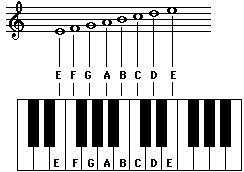
A clef symbol is placed at the
beginning of each staff to fix the location of a specific pitch.
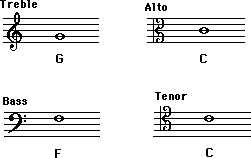
Practice Naming the Notes Below:
Accidentals
Accidentals are symbols that
alter the pitch of a note. Accidentals are placed immediately to the left of the
note they affect.
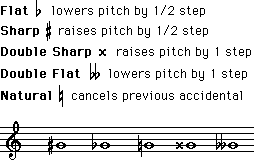
The half step is the smallest
unit of pitch used in Western music. On the piano, a half step is the musical
interval from any one key to its closest neighbor, either black or white. Half
steps occur naturally between the two white key pairs E-F and B-C. Two
consecutive half steps are called a whole step.

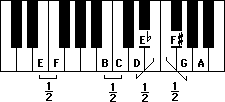
Scales
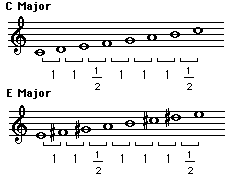
Relative major and minor scales
share the same key signature, but begin on different notes. G major and E minor
are relative major and minor scales.
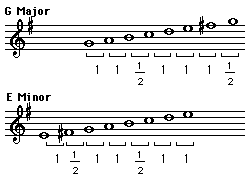
Examples of Melodies
Melodies are like conversations. Musical thoughts are divided into phrases. Often, melodies include two parts - a question and an answer. The melodies below form questions and answers in the key of C major. Notice that all four phrases start on C. The answer is more definitive when the final note in the home key note - in this case a C.
An interval is the distance in pitch between two notes. These can be melodic intervals that or the pitches can sound simultaneously, creating harmonic intervals. The intervals below are harmonic intervals because the notes sound at the same time.
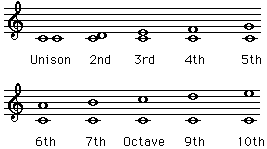
C Major Chord Progression in Bass Clef
A chord includes at least three notes that sound simultaneously in consonant harmony. A triad is a root position chord that includes three tones each 3 steps apart. The chord progression provides the background harmony for songs. Generally, a song in a major key will include the major chords within that scale. The major chords are triads built on the first, fourth, and fifth notes of the scale. In the key of C, the primary chords would be C, F, and G. In this progression a tone 7 notes above the G has been added for flavor. This is called the G7 chord. Notice the guitar tablature notation for the chords played in the bass clef on the piano.

See the course documents under Timbre, Dynamics, and Tempo.
| Abbreviation | Term | Meaning |
|
DYNAMICS |
||
|
|
Crescendo | get louder |
|
|
Diminuendo | get quieter |
| p | Piano | quiet |
|
pp |
Pianissimo | very quiet |
|
ppp |
Pianississimo | very, very quiet |
| mp | mezzo piano | quite quiet |
| mf | mezzo forte | quite loud |
| f | forte | loud |
| ff | fortissimo | very loud |
| fff | fortississimo | very, very loud |
| sf | sforzando | suddenly very loud |
|
The
general rule is to add an "iss" for every added f or p. |
||
| TEMPO INDICATORS | ||
| Adagio | slow | |
| largo | slow and dignified | |
| andante | flowing, at walking pace | |
| allegro | quick and bright | |
| allegretto | a little slower than allegro | |
| vivace | fast and lively | |
| presto | very quick | |
| accelerando | getting faster | |
| ritenuto (rit.) | holding back | |
| rallentando (rall.) | slowing
tempo
flexible tempo |
|
| rubato | flexible tempo | |

Copyright 2003 by Carla Piper, Ed. D.